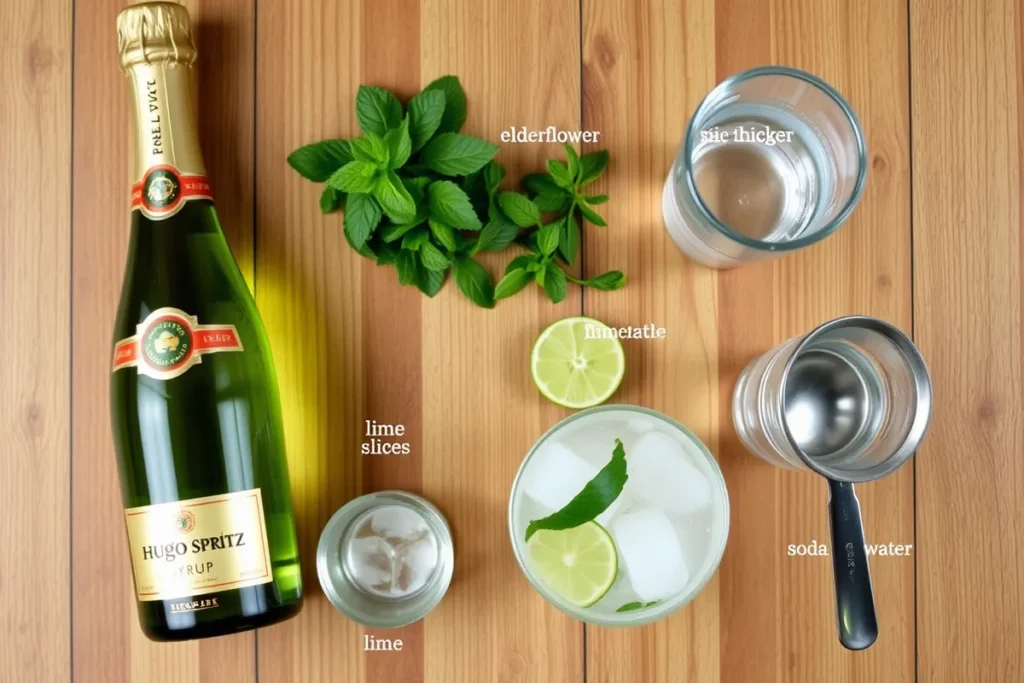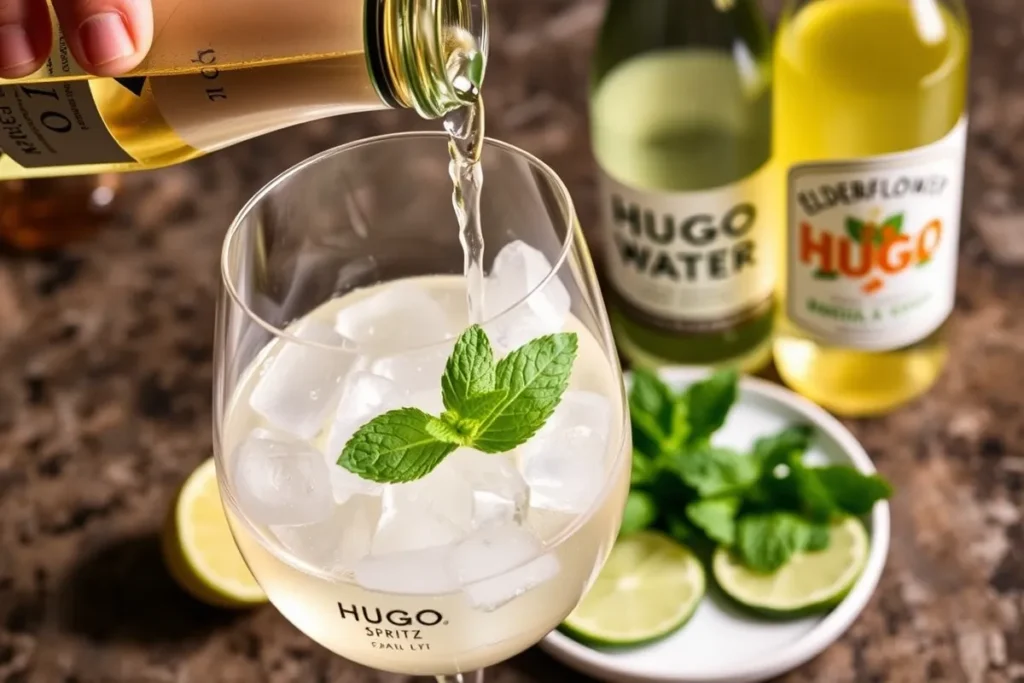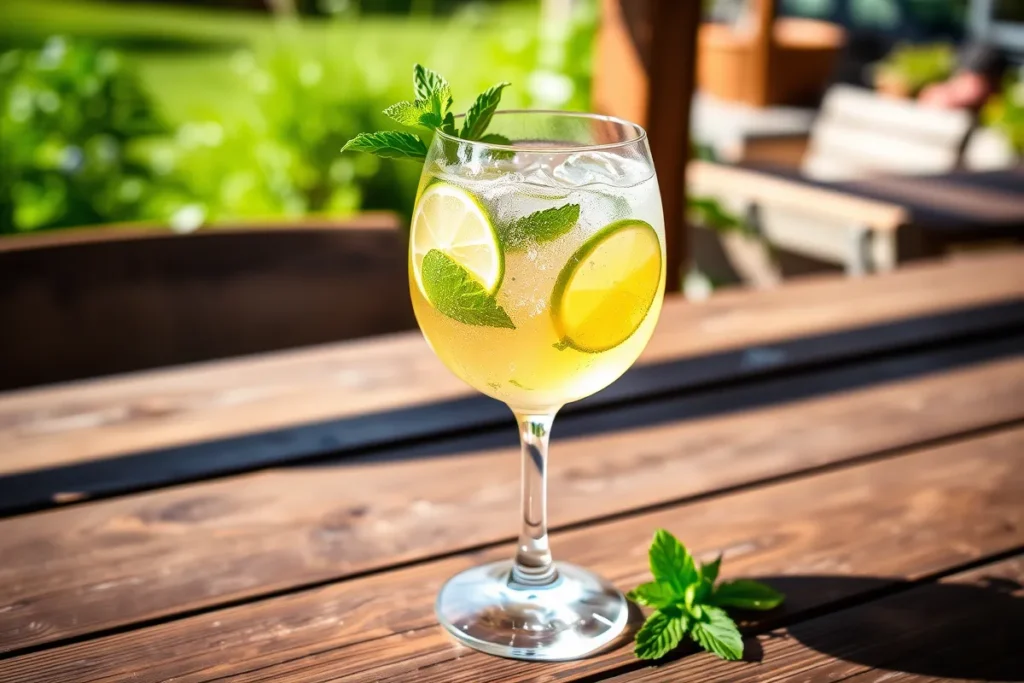The Hugo Spritz Recipe has undoubtedly become a beacon of sophistication and refreshment for cocktail enthusiasts worldwide. Rooted deeply in Italian aperitivo culture, this sparkling drink effortlessly blends Prosecco, elderflower, fresh mint, and a splash of soda water, thereby creating a delicate yet harmonious balance of flavors. Whether you’re hosting a summer soirée or simply looking to unwind, the Hugo Spritz is an inviting choice. In this guide, we’ll explore every aspect of this beloved cocktail—from its history to preparation techniques and creative variations.
Introduction to the Hugo Spritz
Hugo Spritz Recipe: A Tale of Refreshment and Elegance
The Hugo Spritz is not just a cocktail; rather, it’s a delightful symbol of leisurely afternoons and lively gatherings. Originating in Northern Italy, this drink was initially created as a lighter and more floral alternative to the iconic Aperol Spritz. Thanks to its effervescent charm and remarkably simple ingredients, the Hugo Spritz quickly rose to fame, spreading across Europe and eventually captivating audiences worldwide.
Origin and History of the Hugo Spritz
The story begins in the picturesque region of South Tyrol, where bartender Roland Gruber first introduced the Hugo Spritz in 2005. Designed to highlight the floral sweetness of elderflower liqueur, the cocktail became a local favorite before gaining international acclaim. Its light, refreshing profile makes it perfect for those who want something more subtle than bitter aperitifs.
Popularity Across Europe and Beyond
It didn’t take long for the Hugo cocktail recipe to become a staple of café menus from Milan to Munich. As travelers discovered its unique taste, it crossed borders and oceans, bringing a slice of Italian aperitivo culture to global shores. Today, whether you’re in New York or Tokyo, ordering a Hugo Spritz feels like stepping into a charming European piazza.
By blending simplicity with sophistication, the Hugo Spritz continues to capture hearts, becoming more than just a drink—it’s an experience that transports you to sunlit terraces and lively conversations.
Ingredients and Equipment
Essential Ingredients for a Classic Hugo Spritz

The magic of the Hugo Spritz recipe truly lies in its remarkable simplicity and perfect balance. Indeed, each ingredient seamlessly plays a specific role, thereby creating a harmonious blend of floral, citrus, and sparkling flavors. To craft the perfect Hugo Spritz, you’ll only need a few essential ingredients:
- Prosecco: This sparkling Italian wine provides the effervescence and crispness that define the drink.
- Elderflower liqueur or syrup: Adds floral sweetness to the cocktail, offering a delicate contrast to the bubbly wine.
- Soda water: A splash of soda water lightens the drink, ensuring it’s refreshingly effervescent.
- Fresh mint leaves: For an aromatic boost that complements the elderflower’s floral notes.
- Lime slices: Enhance the drink’s citrusy undertones and add visual appeal.
- Ice cubes: Essential for keeping your Hugo Spritz cool and invigorating.
This minimal ingredient list ensures that the Hugo Spritz is both elegant and easy to prepare.
Selecting the Right Prosecco
Not all Prosecco is created equal, and, in fact, choosing the right one can either elevate or completely derail your Hugo cocktail recipe. Ideally, you should opt for a dry or extra-dry Prosecco, as these variations offer just the right level of sweetness to perfectly balance the floral notes of elderflower. Furthermore, look for bottles labeled “DOC” or “DOCG,” as these markings indicate high-quality Prosecco sourced from Italy’s renowned Veneto or Friuli regions.
For a truly luxurious touch, Prosecco Superiore can elevate the drink’s flavor profile. And while Champagne might seem like a tempting substitute, its heavier texture and stronger yeast notes may overpower the cocktail’s delicate balance.
Choosing Between Elderflower Liqueur and Syrup
The choice between elderflower liqueur and syrup ultimately depends on your personal preference and the sweetness level you desire. For instance, liqueurs like St-Germain add depth and complexity to the drink, with their slightly alcoholic edge subtly enhancing the cocktail’s overall aroma and character.
On the other hand, elderflower syrup is non-alcoholic and offers a more concentrated sweetness. It’s an excellent option if you’re crafting a non-alcoholic Hugo Spritz. Either way, the elderflower component is essential for achieving the drink’s signature floral flavor.
Importance of Fresh Mint and Citrus Garnishes
Fresh mint isn’t just a garnish—it’s an integral part of the Hugo Spritz recipe. Its aromatic oils bring a refreshing, herbaceous note that elevates the drink. To release the mint’s full potential, gently clap the leaves between your hands before adding them to the glass.
Lime slices serve both a decorative and functional purpose. Their bright, zesty flavor enhances the drink’s acidity, making each sip more vibrant. You might also experiment with lemon or orange slices for a slightly different twist.
Necessary Equipment for Preparation
Though the Hugo Spritz is delightfully simple, having the right tools ensures a smooth and enjoyable preparation process. Here’s what you’ll need:
- Large wine glasses: These provide ample room for ice, Prosecco, and garnishes, allowing the flavors to mingle beautifully.
- Bar spoon: For gently mixing the ingredients without losing the bubbles.
- Jigger or measuring cup: To maintain precision when adding elderflower liqueur or syrup.
- Ice tongs: Essential for hygienically handling ice cubes.
With these ingredients and tools at your disposal, you’re well-equipped to create a showstopping Hugo Spritz every time.
Step-by-Step Preparation Guide
How to Prepare the Perfect Hugo Spritz

Now that you have your ingredients and tools ready, it’s time to bring them together into a refreshing masterpiece. The Hugo Spritz is all about balance, so precision is key. Follow these steps to craft the ultimate cocktail:
Preparing the Glassware
Start by selecting a large, clean wine glass. Rinse it with cold water to chill the glass slightly, or place it in the freezer for a few minutes. A cold glass not only keeps your drink crisp but also enhances the experience with frosty visuals.
Once chilled, fill the glass with ice cubes. This ensures that the drink remains cold and maintains its sparkle. Don’t skimp on the ice—it’s a crucial part of the Hugo Spritz’s refreshing nature.
Measuring and Mixing Ingredients
- Pour 150ml of Prosecco into the prepared glass. Tilt the glass slightly to avoid excessive foam and preserve the bubbles.
- Add 50ml of elderflower liqueur or syrup, adjusting the amount to your sweetness preference.
- Top with a splash of soda water—around 30ml is sufficient.
Using a bar spoon, you should gently and carefully mix the ingredients, so that the flavors blend harmoniously without disrupting the delicate effervescence. In the end, the goal is to create a perfectly seamless balance of floral, citrus, and bubbly notes, which, as a result, truly captures the unique charm of the Hugo Spritz.
Garnishing Techniques for Visual Appeal
For the final touch, add 2–3 fresh mint leaves, clapping them gently to release their aroma. Slide a thin lime slice along the glass’s rim before dropping it in as a garnish. If you’re feeling creative, a twist of lemon peel or edible flowers can add an extra flair.
With these steps, you’ll achieve a beautifully balanced Hugo Spritz recipe that’s as visually captivating as it is delicious.
Variations and Personalizations
Creative Variations of the Hugo Spritz
The beauty of the Hugo Spritz recipe lies in its adaptability. While the classic recipe is undeniably delicious, experimenting with flavors can add a personal twist to your drink. From fruity infusions to herbal accents, the possibilities are endless. These variations keep the Hugo fresh, exciting, and perfectly suited to different tastes and occasions.
Incorporating Different Fruit Infusions
Adding fruit infusions to the Hugo cocktail recipe introduces a delightful pop of flavor and color. Consider these ideas:
- Berries: Muddle fresh raspberries, blueberries, or strawberries into the drink for a sweet and tart twist.
- Citrus fruits: Beyond lime, try adding grapefruit or blood orange slices for a more complex citrusy undertone.
- Tropical fruits: Pineapple or passion fruit purée can transport your Hugo Spritz to an exotic paradise.
These fruits not only enhance the flavor but also create a visually stunning cocktail. For best results, use fresh, ripe fruits and adjust the elderflower liqueur or syrup to balance the added sweetness.
Adjusting Sweetness Levels to Taste
One of the simplest and most effective ways to personalize your Hugo Spritz is by fine-tuning its sweetness. For instance, if you prefer a drier version, you can opt for an extra-dry Prosecco and reduce the amount of elderflower liqueur or syrup. On the other hand, if you have a sweet tooth, you might consider increasing the elderflower component or even adding a small splash of simple syrup for an extra touch of sweetness. This flexibility ensures that your Hugo Spritz is perfectly tailored to your taste.
Another option is to introduce a bittersweet note by adding a dash of Aperol or Campari. This adjustment not only balances the sweetness but also adds a layer of complexity to the drink.
Non-Alcoholic Versions: The Virgin Hugo
The Virgin Hugo is a fantastic option for those who prefer a non-alcoholic alternative. Replace Prosecco with sparkling water or non-alcoholic sparkling wine. Use elderflower syrup instead of liqueur to maintain the cocktail’s signature floral flavor.
To add a touch of sophistication, include fresh fruit infusions or herbal garnishes like rosemary or thyme. The result is a mocktail that’s just as refreshing and elegant as the original, perfect for any occasion.
Serving Suggestions
Ideal Occasions for Serving Hugo Spritz
The Hugo Spritz recipe is incredibly versatile, making it suitable for a range of occasions. Its light and refreshing nature make it a favorite during:
- Outdoor gatherings: Serve it at summer barbecues, garden parties, or picnics for a sophisticated touch.
- Celebrations: Its sparkling allure is perfect for weddings, birthdays, and anniversaries.
- Casual evenings: Whether relaxing on the patio or hosting friends, the Hugo Spritz adds a delightful charm to any moment.
No matter the occasion, the Hugo Spritz sets the tone for a relaxed and enjoyable atmosphere.
Pairing Hugo Spritz with Appetizers
Pairing the Hugo cocktail recipe with the right appetizers can enhance the drinking experience. Its floral and citrusy notes work well with:
- Light bites: Caprese skewers, bruschetta, or prosciutto-wrapped melon.
- Seafood: Shrimp cocktail, smoked salmon canapés, or oysters.
- Cheese boards: Include soft cheeses like brie or goat cheese, complemented by fresh fruit and honey.
These pairings emphasize the Hugo’s bright and refreshing qualities, creating a balanced and memorable experience.
Seasonal Considerations: Summer vs. Winter
While the Hugo Spritz is synonymous with summer, it can easily transition into a year-round favorite:
- Summer: Serve it over plenty of ice with extra mint and lime for maximum refreshment.
- Winter: Try a warmer variation by replacing soda water with a hint of sparkling apple cider and garnishing with rosemary or cinnamon.
Adapting the Hugo Spritz to the season ensures that its charm remains timeless, making it a cocktail for all climates.
Health and Safety Considerations
Alcohol Content and Responsible Consumption
ared to many other mixed drinks, making it a relatively light choice for casual sipping. With Prosecco as its base and elderflower liqueur or syrup as a sweetener, the alcohol content typically ranges between 8–11% ABV, depending on the Prosecco and liqueur used.
However, even light cocktails can lead to overconsumption if enjoyed in excess. To drink responsibly:
- Limit your intake to one or two servings during a single occasion.
- Pair the drink with food to slow alcohol absorption.
- Stay hydrated by alternating with water or other non-alcoholic beverages.
For those who are abstaining or hosting guests who prefer to skip alcohol, the Virgin Hugo is an excellent alternative, offering the same delightful flavors without any alcohol content.
Caloric Information and Dietary Considerations
The Hugo cocktail recipe is relatively light in calories compared to richer, cream-based cocktails. A standard serving of the Hugo Spritz typically contains approximately 120–150 calories, depending on the proportions and specific ingredients used. However, if you’re looking to reduce the calorie content, you can opt for low-sugar or non-alcoholic variations of Prosecco and elderflower syrup. This simple adjustment allows you to enjoy the cocktail’s refreshing flavors while keeping it lighter and more diet-friendly.
For dietary adjustments, consider these tips:
- Use sugar-free elderflower syrup for a diabetic-friendly option.
- Replace soda water with sparkling mineral water to eliminate any added sodium.
- Experiment with fresh fruit or herbal infusions for natural sweetness without added sugar.
These modifications make the Hugo Spritz accessible to a wider range of dietary preferences without sacrificing its signature taste.
Frequently Asked Questions (FAQs)
FAQs about Hugo Spritz
As one of the most popular cocktails in modern mixology, the Hugo Spritz recipe frequently sparks curiosity among enthusiasts and casual drinkers alike. Therefore, to help you better understand this delightful cocktail, here are answers to some of the most common questions you might have.
What is the origin of the Hugo Spritz?
The Hugo Spritz originally emerged in South Tyrol, Italy, back in 2005. Notably, it was created by the innovative bartender Roland Gruber, who, in an effort to offer a lighter and more floral alternative to the Aperol Spritz, skillfully introduced this unique drink. Over time, and as word quickly spread, this delightful cocktail gradually gained popularity and, eventually, captured the hearts of cocktail enthusiasts across the globe.
Can I use Champagne instead of Prosecco?
While Champagne can be used, its stronger yeast notes and heavier texture may overpower the drink’s light, floral profile. Prosecco is recommended.
How can I make a non-alcoholic Hugo Spritz?
To craft a Virgin Hugo, replace Prosecco with sparkling water and use elderflower syrup instead of liqueur. Add fresh mint and lime for garnish.
What foods pair well with a Hugo Spritz?
The Hugo cocktail recipe pairs beautifully with light, flavorful bites such as a fresh Caprese salad, delicate seafood dishes, or cheese platters featuring soft cheeses like brie or goat cheese. These pairings complement the cocktail’s crisp and floral notes, enhancing the overall dining experience.
How do I properly garnish a Hugo Spritz?
To finish, garnish your Hugo Spritz with fresh mint leaves and lime slices. For an added aromatic touch, gently clap the mint leaves between your hands to release their natural fragrance before placing them on top. This simple step not only enhances the drink’s aroma but also adds a visually appealing, elegant touch to your cocktail.
Is elderflower liqueur the same as elderflower syrup?
No, elderflower liqueur contains alcohol and is less sweet, while elderflower syrup is non-alcoholic and has a more concentrated sweetness.
Conclusion
The Hugo Spritz recipe is more than just a drink; it’s a celebration of balance, flavor, and elegance. Whether enjoyed during a sunlit summer afternoon or adapted for a cozy winter gathering, this versatile cocktail never fails to impress. By understanding its origins, experimenting with variations, and pairing it thoughtfully, you’ll find endless reasons to toast with a Hugo Spritz. Cheers to embracing this delightful aperitif and making it your own!


2 thoughts on “How to Make the Perfect Hugo Spritz Recipe: A Refreshing Delight”